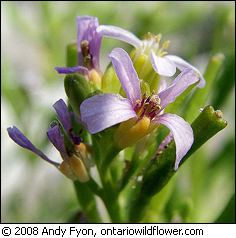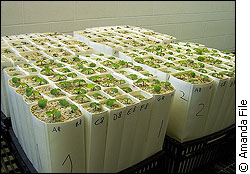
|
|
But this common misconception is facing a strong, maybe final, challenge from a study, published in the June 2007 issue of Biology Letters. “I feel our study shows that plants have abilities and lives that we often don't think about,” says Susan Dudley, one of the study's co-authors and an associate professor of biology at McMaster University.
The study, conducted with her then-fourth-year student Amanda File, indicates that plants can tell the difference between siblings and strangers and will act in very different ways depending on who they are growing beside. To come to this conclusion, Dudley and File examined the root growth of the Great Lakes sea rocket, a scraggly mustard plant that grows on sandy beaches. The experiment divided 64 seeds into three distinct groups:
After eight weeks, File chopped off the leaves, stems and flowers at soil level and weighed this above-ground mass. Determining the weight below-ground was more difficult because in most cases the roots of neighbouring plants had tangled together. “It was a little bit painstaking,” says File. “You don't want to miss or damage any roots.” Eventually she weighed the tangled fine roots together and calculated an average ratio of above to below growth for each pot. The results indicated that plants growing with kin grew fewer fine roots than those growing with groups of strangers. Lending a helping root This is significant, not only because it shows plants can interact in surprising ways but also because root growth is one of the primary ways for plants to compete over resources. When a plant is surrounded by other plants, it is expected to grow bigger, deeper roots so that it can suck up more nutrients.
“Dudley and File showed evidence that kin groups did better as a whole because they didn't waste root mass competing with each other,” said Kathleen Donohue, an evolutionary biologist at Harvard University. Donohue herself conducted a study on Great Lakes sea rocket in 2003. It is one of many earlier studies that showed that plants could benefit from growing with their siblings, an idea called “kin selection.” This study's indication that plants might limit their own growth to help out others is called “altruism” by biologists, sacrificing the good of the individual for the good of the group. But Donohue warns that this shouldn’t be confused with noble intentions. “A positive effect from growing with kin doesn't require benevolent feelings on the part of the plant. The positive effect is just incidental, not intentional,” she says. A tangled question Since the Dudley and File study was published, some questions have arisen about how widespread kin recognition in plants might be. Two studies into other plant species have found that they could not recognize siblings. Dudley says that factors such as how far seeds are spread out and whether a particular species tends to grow in tight clumps of kin will affect whether or not a species has adapted to recognize kin. But Dudley and File’s process has also concerned some scientists, such as Jeffrey Klemens of the University of Minnesota. He has called into question the method used to compare root mass and says that the methods of data analysis could also turn up faulty results.
His key argument is that by averaging the above-ground and below-ground masses in the way they did, the entire result is biased toward the largest plant. If one plant in a pot grew much larger than its neighbours, the entire pot would seem to have done better. “The fundamental question in a study like this is the responses of individual plants, and this way of measuring obscures those responses,” he says. Dudley acknowledges that these kinds of questions can arise as she and File chose not to publish their raw statistics with the original study. But she feels the results are still clear. “Statistics do matter, but we’re looking at the production of roots where you can actually see the results. I think it’s easier for people to understand,” she says. For File, the results of the study are still stunning. "You find something like this and remember how amazing plants are," she says. If these results do hold, the study emphasizes the need for farmers and gardeners to carefully plan what they pair up in a plot of land. It might be worth their while to pay attention to their garden’s family trees when preparing for a new planting season.
|
|
|

